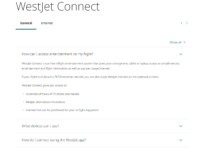In the modern digital age, staying connected is crucial for various purposes such as work, communication, entertainment, and productivity. In-flight WiFi facilitates real-time communication, allows passengers to work remotely, and provides entertainment options, enhancing the overall travel experience. It utilizes advanced technologies, including satellite and air-to-ground systems, to establish a connection between the aircraft and the ground-based stations.
Table of Contents
Accessing Basic Internet Services
In-flight WiFi enables passengers to browse the internet and use search engines like Google, Bing or Yahoo. However, due to the limitations of bandwidth and speed, web pages may load slower compared to regular ground-based connections. Users can access information, news, and other online resources but might experience delays in loading content.
Email services like Gmail, Outlook, and Yahoo Mail are typically accessible through in-flight WiFi. However, large attachments or media-heavy emails may take longer to download or send due to bandwidth constraints. Users can stay connected with their professional and personal networks, but efficiency might be affected by the limited internet speed.
Social Media and Messaging
In-flight WiFi provides access to various social media platforms such as Facebook, Twitter, Instagram, and LinkedIn. Passengers can scroll through feeds, post updates, and interact with content. However, the functionality might be limited, especially concerning media uploads and high-resolution images or videos.
Passengers can use messaging applications like WhatsApp, Messenger, WeChat, and Slack to stay in touch with friends, family, or colleagues. Text messages and voice calls are generally supported, although video calls might face connectivity issues or reduced quality. While messaging services are more data-efficient than media-heavy social media apps, the speed and responsiveness of the connection can impact the user experience.
Streaming and Entertainment
In-flight WiFi allows passengers to stream music from platforms like Spotify, Apple Music, or Pandora. While many airlines partner with specific streaming services, users may experience limitations. Some airlines offer pre-selected playlists or albums for streaming to conserve bandwidth. Alternatively, passengers can download music before the flight to enjoy it offline, bypassing the need for real-time streaming, which can be affected by the limited internet speed.
Passengers can access video streaming services such as Netflix, Hulu, YouTube, and Amazon Prime Video. Similar to music streaming, some airlines offer a selection of movies and TV shows for passengers to watch. However, streaming quality can be reduced to prevent buffering, and the selection might be limited. Users should be mindful of the available options and download content strategically to optimize their in-flight entertainment experience.
Work and Productivity
In-flight WiFi allows passengers to work on documents collaboratively using cloud-based platforms like Google Docs, Microsoft Office Online, or Dropbox Paper. These services enable real-time editing and collaboration, making it convenient for professionals to continue working on projects or documents while in the air. However, the speed of in-flight WiFi may affect the responsiveness of these applications, and users might experience slight delays in document syncing and real-time editing.
Passengers can use Virtual Private Networks (VPNs) to enhance security and privacy while connected to in-flight WiFi. VPNs encrypt the internet connection, ensuring a secure browsing experience. This is particularly important when accessing sensitive information or conducting online transactions. However, while VPNs offer enhanced security, they might also slow down the internet speed further due to the additional encryption and rerouting of data. Passengers should consider the balance between security and speed when using VPNs during their flight, understanding the potential trade-offs involved.
Gaming and Online Activities
In-flight WiFi allows passengers to engage in online multiplayer games, connecting with players worldwide. Gaming platforms like Steam, Xbox Live, or PlayStation Network can be accessed, providing a gaming experience while traveling. However, online gaming over in-flight WiFi can be challenging due to latency issues. The delay between actions and their reflection in the game, caused by signal transmission to and from the aircraft, can affect gameplay. While turn-based or less latency-sensitive games might work well, fast-paced multiplayer games could be less enjoyable due to the delay.
Passengers can shop online and make transactions using in-flight WiFi, accessing e-commerce websites like Amazon, eBay, or various retail stores. While this provides convenience, users should be cautious about security. In-flight WiFi networks, like any public WiFi, can be vulnerable to hacking attempts. To enhance security, it is advisable to use secure, encrypted connections (https://) for online transactions. Additionally, users should avoid accessing sensitive financial information over public networks to minimize the risk of data theft or unauthorized access.
Conclusion
In-flight WiFi has transformed the way people stay connected and entertained while traveling. It has facilitated remote work, enabled real-time communication, and provided entertainment options, making long flights more bearable. Despite the existing challenges, in-flight connectivity has become an essential feature for modern travelers, bridging the gap between the sky and the digital world.
Innovations such as improved satellite technology, enhanced air-to-ground systems, and increased bandwidth availability are expected to address current limitations. Passengers can anticipate a more seamless and satisfying in-flight internet experience in the years to come.





